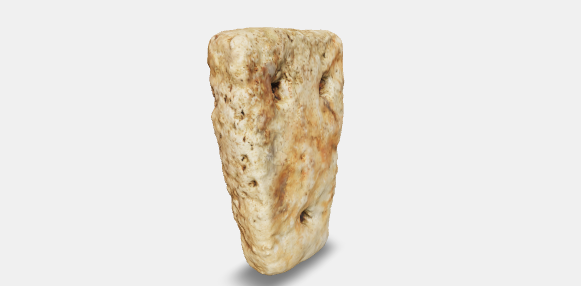Trapezoidal stone anchor with three holes. Circular upper hole with quadrangular lower holes. Traces of lithophagous organisms.
The artefact presents clear traces of perforations caused by endolithic animal organisms. There are numerous small circular holes over a large part of the surface that may be attributable to endolithic boring sponges (family Clionaidae), visible also thanks to the presence of dense confluent chambers in the material actively dug by the sponges. Some of them present a purplish pigment, visible mainly around the upper hole of the stone anchor. It may be attributable to the growth of an endolithic sponge characterised by a well visible pink-purplish colouration, known as Cliona schmidtii and already found on other underwater archaeological artefacts.
There are also some peculiar, 8-shaped holes that correspond to the external openings of the tunnels dug in the rock by bivalve molluscs Rocellaria dubia, a species that colonises underwater calcareous substrates. As far as the epilithic encrusting colonisation is concerned, there are specimens of Polychaeta Serpulidae with their characteristic calcareous tubes and white encrusting Bryozoa colonies. Finally, there is an irregularly shaped hole resulting from the confluence of tunnels, which may be attributable to the perforating bivalve Lithophaga lithophaga (date mussel).

Ricci S., Sacco Perasso C., Antonelli, F., Davidde Petriaggi B., 2015. Marine Bivalves colonizing roman artefacts recovered in the Gulf of Pozzuoli and in the Blue Grotto in Capri (Naples, Italy): boring and nestling species. International Biodeterioration & Biodegradation (98) 89 – 100.
Ricci, S., Pietrini, A. M., Bartolini, M., Sacco Perasso, C., 2013. Role of the microboring marine organisms in the deterioration of archaeological submerged lapideous artifacts (Baia, Naples, Italy). International Biodeterioration & Biodegradation 82 (2013) 199-206.
Ricci S., Davidde B., Bartolini M., Priori G. F., 2009. Bioerosion of lapideous objects found in the underwater archaeological site of Baia (Naples). Archaeologia Maritima Mediterranea, 6: 167-188.
Many scholars have attempted to study the so-called lithic anchors. Among them, Honor Frost, Dan E. McCaslin, Alessandra Nibbi, Shelley Wachsmann and János Attila Tòth have developed chronologies and tables that are often conflicting. However, we can affirm that this typology, precisely because of its simplicity, is undoubtedly very ancient and can be found since the Bronze Age, as evidenced by the specimens found in the sanctuary of Ugarit. Certainly not limited only to this period, as stated by McCaslin, given that the wrecks of Antidragonera and Ognina D have returned some of them. A similar argument applies to Frost’s theories, who at the end of the 1990s wanted them to be used only on the Phoenix ships and abandoned in the Iron Age due to their weight.
To demonstrate that this particular type of anchor had a chronologically wide use we can mention the finds from the medieval era (14th century), with one or more holes, published by Avner Raban and coming from the port of Caesarea from certain and sealed stratigraphies. Raban also documents its use in Italy in recent years.
It is also certain that many of these finds had alternative uses to the more intuitive ones of anchoring. Particular shapes would seem to lead more to uses linked to fishing such as dead bodies or reused threshing stones.
Frost H. 1969, The stone anchors of Ugarit, in Ugaritica 6, pp. 235-245.
Frost H.1973, Anchors, the potsherds of marine archaeology: on the recording of pierced stones from the Mediterranean, in D.J. Blackman (Ed.), Marine Archaeology, London, pp. 397-406.
Frost H. 1997, Bronze age stone anchors (Eastern Mediterranean), in J.P. Delgado (Ed.), Encyclopaedia of Underwater and Maritime Archaeology, London, pp. 74-75.
Galasso M. 2000, Ancore di pietra fra archeologia ed etnografia, in Archeologia Postmedievale, 4, pp. 265-282
Gianfrotta P. A., Pomey P. 1981, Archeologia subacquea, storia, tecniche, scoperte e relitti, Milano.
Gianfrotta P.A. 1983, Recensione a Dan E. McCaslin: Stone Anchors in Antiquity, in Gnomon 55, pp. 336-339.
Gibbins D. 2001, Shipwreck and ellenistic trade, in Zofia H.A., Davies J., Gabrielsen V., Oliver G.J. (eds.), Hellenistic Economies, , London-New York,
Kapitän G. 1984, Ancient Anchors – Tecnology and Classification, in IJNA 13.1, pp. 33-44
Kingsley S.A., Raveh K. 1994, Stone anchors from Byzantine contexts in Dor Harbour, Israel, in IJNA 23, pp. 1-12
Kingsley S.A., Raveh K. 1996, The Ancient Harbour and Anchorage at Dor, Israel. Results of the underwater surveys 1976-1991, BAR Int. Series 626, Oxford.
Kourkoumelis D. 2000, The Antidragonera Wreck (Kythera, end of 4th century BC), Island in Archaeology: Vorgeschichte, Klassische Antike, Mittelalter, Neuzeit (Internationaler Kongress 10-12 Juli 1998, Starnberg), in Archäologie unterWasser 3, München,
Kourkoumelis D. 2004, Les ancres pyramidales en pierre. Problèmes et techniques d’ancrage des navires au IV siècle av. J.-C., in Brun J.P., Philippe J. (Eds.), Texnai. Techniques et societès en Mèditerranèe, Paris, pp. 649-661.
Mccaslin D.E. 1980, Stone Anchors in Antiquity: Coastal Settlements and Maritime Trade-Routes in the Eastern Mediterranean ca. 1600-1050 B.C., Göteborg.
Nibbi A. 1993, Stone anchors: the evidence re-assessed, in The Mariner’s Mirror 79, pp. 5-26.
Raban A. 2000, Three-hole composite stone anchors from a medieval context at Caesarea Maritima, Israel, in IJNA 29.2, pp. 260-272.
Riccardi E. 1996, Ancore, in Ciciliot F. (ed), Navalia – archeologia e storia, Savona, pp. 9-30
Tòth J.A. 2002, Composite stone anchors in the ancient Mediterranean, in Acta Archaeologica Academiae Scientiarum Hungaricae 53, pp. 85-118.
Wachsmann S. 1998, Seagoing Ships and Seamanship in the Bronze Age Levant, College Station- London .



